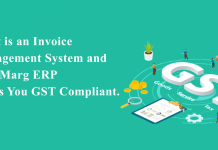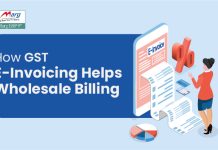Article Content
Table of Contents
ToggleWhen E-Invoicing System Introduced in India?
Earlier from 1st October 2020, e-Invoicing process under GST for taxpayers with an aggregate turnover above Rs. 500 crores was implemented. It was then made mandatory for the taxpayers with an annual turnover above Rs. 100 crores from 1st January 2021. In the next phase, the government plans to bring all businesses under the e-invoicing process from 1st April 2021. Aggregate turnover for e-invoicing will include the turnover of all GSTINs under a single PAN across India.
What is E-Invoicing?
Electronic invoicing or e-Invoicing in India is a process of generating invoices, under which invoices created by one software can be accessed by other software, removing the requirement for any new data entry or errors. In less difficult words, it is an invoice generated utilizing a standard format, where the electronic information of the invoice can be shared to other people, consequently ensuring compatibility of information.
Electronic Invoicing is a system in which Business-to-Business (B2B) invoices, Export invoices, and Credit/Debit Notes are validated electronically by GSTN for further use on the common GST portal. An e-invoice authenticates transactions and provides one unique identification number (Invoice Registration Number or IRN) against each invoice that will further be managed by the Invoice registration portal (IRP) by GSTN.
In August 2019, the government announced the implementation of e-invoice for the public. Later GST council modified it to be compliant according to their regulations. The standard format makes GST compliance easier because it is followed over Pan India across all industries, interoperability between GST ecosystems is thus ensured.
Understand Current System of E-Invoicing in India
Earlier, invoice generated by the seller needs to be prepared and reported to GST Portal and e-Way Bill.
Usually, taxpayers generate invoices using different software as per the availability and the invoice details are entered using a suitable API in a GSTR-1 return. The same information is then reflected in the GSTR-2A and is available to recipients with ‘view only’ permission. Simultaneously, transporters need to generate the e-Way Bill, either directly or by importing the invoices into an excel sheet or JSON manually.
To curb this endless trail of paperwork & put an end to this process, the GST council on India introduced the new GST return filing system i.e. e-invoicing in India.
Why E-Invoicing is Introduced?
The main two reasons behind the introduction of e-invoicing system under GST is to:
- Follow a standard format which will allow invoices to be shared easily
- Invoices thus generated through the system can be read easily by the central system
The main objective behind the introduction of e-Invoicing by the tax departments is to ease the whole process of invoicing i.e. to reduce all the reconciliation problems related to data and auto-populate the returns that will help the taxpayers to easily get the Input Tax Credit. With e-invoicing, fields will be pre-populated while filing returns, thus avoiding discrepancies, errors etc during data entry and reconciliation.
Applicability of E-Invoicing System
- E-Invoicing system (Electronic invoicing system) has been introduced by GST Council in its 35th GST Council Meeting.
- The standard format of e-invoice was approved in its 37th GST Council Meeting held on 20.09.2019.
- Every GST registered person whose aggregate turnover crosses Rs. 100 crore rupees is required to issue an e-invoice with effect from 1st April 2020.
- Further, e-Invoicing system will become mandatory from 01.04.2020 to record Business to Business (B2B) invoices to GST System.
- It has also been decided to be implemented from 01.01.2020 on a voluntary basis.
- e-Invoicing is applicable for generating business to business (B2B) invoices only on voluntary basis i.e. it records Business to Business (B2B) invoices to GST System.
What are the Benefits of E-Invoicing?
Some of the key benefits of e-invoicing are as follows:
Standardization
The generated e-Invoice can be used for GST Returns i.e. GSTR 1 or GST ANX – 1 and for generating the e-way bill. The majority of the information in structure GSTR-1 can be saved prepared for documenting while at the same time utilizing e-invoicing format.
Seamless Reconciliation
There would be seamless reconciliation and authentication of data between the suppliers and the recipient resulting in better control over Input Tax Credit (ITC) and claim.
Lesser Compliance
It helps the taxpayers to reduce the overall burden of the compliance. There will be a massive reduction in the issues related to input credit verification as the same data will get recorded to the buyer as well to the tax department in the inward supply register.
Reduces Data Entry Work
The e-Invoices generated on one software are easily readable by another that helps in reducing the need for manual and multiple data entries.
Elimination of fake invoices
With e-Invoicing, the chances of errors and mistakes get decreased resulting in the reduction of tax evasion and eliminate the generation of fake invoices.
Easy to keep track of Invoices
It helps to keep a proper track of all the created invoices i.e. when an invoice has been sent, paid, viewed, and received through the e-invoicing system.
Different Modes to Generate E-invoice
Under GST, IRP (Invoice Registration Portal) has provided multiple modes for all the taxpayers for the creation of an e-Invoice which are as follows:
- Web-Based
- API Based
- Offline Tool
- Mobile App-Based
- Through SMS
- Through GSP
Basically, the GST e-invoice system has two parts of the process:
- Communication between the business and the Invoice Registration Portal (IRP)
- Interaction between the IRP, the GST/ e-Way Bill systems, and the buyer.
How To Generate an E-Invoice?
There are not many changes; businesses can continue to generate their invoices from their existing software just as before. To ensure a level of standardization only a standard format, the schema will be used to generate the e-invoices. The generation of these systematic invoices will be done by the taxpayer. While generating the invoices, he/she has to report it to the GST Invoice Registration Portal (IRP). Then the portal will generate a unique invoice reference number & adds the digital signature along with the QR code on to the e-invoice. It will also sign the e-invoice digitally and generate a QR code. Further, all the important guidelines of an e-Invoice will be included in the QR Code and return it to the taxpayer who has generated the document. Also, the receiver will be provided the signed e-Invoice document by IRP to an email which is already been provided in the e-invoice.
Mandatory Parameters for E-invoicing
- Transaction details like tax, supplier type
- Document details: type, number and date
- Supplier information like GSTN address, legal name, location, state code & PIN code
- Buyer information like GSTN address, legal name, location, state code & PIN code
- Dispatch from address details (mandatory in case it is different from the address of address)
- Shipping details (mandatory in case it is different from the address of address)
- Item related details like service/ goods, Assessable amount, HSN code, total amount, GST rate, total item value
- Batch number if the items are being moved in batches
- Invoice details including assessable values and total invoice value.
How to Generate E-Invoice Unique IRN?
The IRN must have GSTIN, Type of document (Regular B2B Invoice, Export or Credit/Debit Note), Number of document and Financial Year of the seller. The IRP will generate a hash parameter based on the details as mentioned. The IRP will then check it from the Central Registry of the GST System in order to assure that the same document (invoice etc.) from the same supplier referring to the same Financial year is not uploaded again. And after confirming there are no duplicates, the IRP will add its signature and a QR code in the invoice’s JSON data. The hash generated by the IRP will be the Invoice Reference Number (IRN) for the e-invoice.
How you can Update the E-Invoice to the GST System?
After the e-invoice has been checked and authenticated by the portal, a digitally signed JSON with unique IRN is sent to the seller. The uploaded e-invoice is then shared with the GST and e-Way Bill system. The GST portal will then update the GSTR-1 for the seller and GSTR-2A for the buyer. The GST e-invoice schema will contain details like ‘Transporter ID’ or ‘Vehicle number,’ which will be used to generate an e-Way Bill.
On the GST portal, generation of e-invoice is not allowed. E-invoicing can only be done with the accounting/ billing software of the seller and their respective ERP solution. The IRP will just receive, validate, and digitally sign the invoices uploaded by the seller.
How E-Invoicing in India Will Help in Reducing Frauds?
With the introduction of e-invoicing in India, as the e-invoices will be directly uploaded to the portal & tax professionals will now have access to a complete trail of B2B invoices from taxpayers. Due to the generation of e-invoices before any actual transaction has taken place, chances of errors & duplicates e-invoices decrease. The system can identify fake invoices by matching the input tax credit to the output tax on the GSTN portal. Therefore this process will prevent tax crimes.
Road Ahead for E-Invoicing in India
e-Invoicing will help the businesses in the long run and will move forward in the digital age. The Introduction of the e-Invoice system will streamline the GST process i.e. it will automate the tax return filing processes as all the required details related to the invoices will auto-populate the returns that will help the taxpayers to easily get the Input Tax Credit.
E-Invoicing System will reduce all the reconciliation problems related to data entry and will increase transparency, save cost and initiate faster payments.







It’s very nice and very useful for me. Thanks for sharing useful information with us.